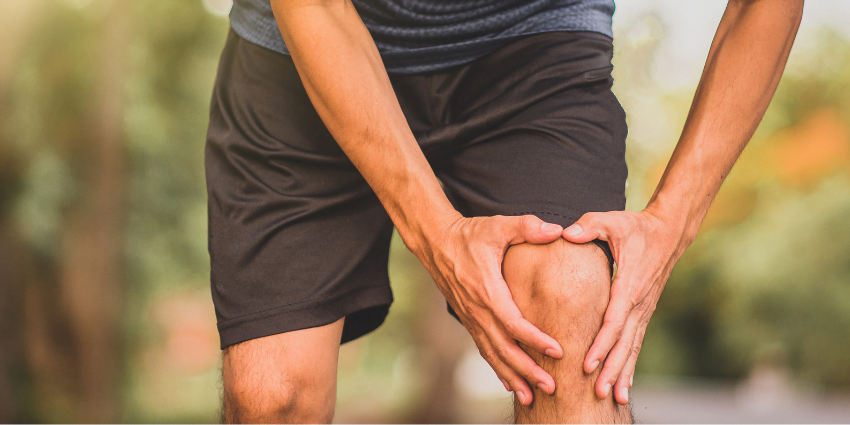Comment soulager une douleur au genou ?
Les douleurs du ou des genoux, ou gonalgies, sont un symptôme très courant. Elles peuvent survenir brutalement après un traumatisme, comme une fracture ou une entorse. Dans les autres cas, elles apparaissent plus progressivement et ont une cause mécanique ou inflammatoire. La médecine chinoise est appropriée pour traiter ce type de douleur que ce soit au travers de l’acupuncture ou du Tuina.
Un programme d’entraînement bien équilibré ne se limite pas aux étirements seuls : l’échauffement, le retour au calme et la récupération sont également essentiels. Les étirements du genou sont un élément simple que de nombreuses personnes ont tendance à ignorer, même si elles souffrent de douleurs au genou.
Il peut être judicieux d’inclure des étirements pour les douleurs au genou dans votre programme de remise en forme. En effet, il est assez courant que les douleurs au genou soient dues à une raideur ou une faiblesse au niveau des hanches, des fessiers et des membres inférieurs.
Sommaire
Voici les étirements que je vous propose
- Étirement des fléchisseurs de la hanche
- Étirement des fessiers
- Étirement des ischio-jambiers
- Étirement des mollets
- Étirement des quadriceps
- Étirement du quadriceps debout
- Étirement des adducteurs en fente latérale
Pourquoi j’ai mal au genou ?
La douleur au genou survient souvent ou s’aggrave en raison d’une faiblesse ou d’une raideur des muscles et des tendons qui relient les genoux, en particulier les hanches, les fessiers, les ischio-jambiers, les mollets et les quadriceps. Ces muscles, allant de vos hanches à vos orteils, travaillent tous ensemble pour soutenir vos articulations pendant que vous bougez. Ils forment ce que l’on appelle une chaîne musculaire. Comme ils sont tous reliés et travaillent ensemble, quand l’un d’entre eux est affaibli, les autres en sont impact.
Bien entendu, la douleur au genou peut également être due à une blessure. Par exemple, les coureurs ont tendance à développer le syndrome de la douleur fémoro-patellaire (aussi appelé syndrome fémoro-rotulien), qui provoque une douleur sourde et douloureuse au niveau de la rotule lorsqu’ils courent en montée ou descendent les escaliers. Ces derniers ont aussi tendance à développer le syndrome de l’essuie-glace (aussi appelé tendinite du fascia lata) qui induit une douleur strictement mécanique localisée au niveau de la face externe du genou. Si vous ressentez ce type de douleur au genou, ou toute autre douleur au genou qui est aiguë, qui s’aggrave progressivement, qui s’accompagne d’un gonflement ou d’un bruit sec, vous devriez consulter votre médecin ou votre physiothérapeute.
Il est important de renforcer les zones qui soutiennent l’articulation du genou, car ces muscles peuvent contribuer à réduire le stress sur le genou ainsi que les chocs sur l’articulation. Les mouvements de force, en particulier les exercices sur une seule jambe, peuvent vous aider à vous concentrer sur le renforcement d’une hanche à la fois, ce qui peut contribuer à éviter les déséquilibres de force.
Mais il ne s’agit pas seulement de développer la force. C’est pourquoi il est important d’inclure les étirements du genou dans votre programme de remise en forme. Les étirements des zones renforcées permettent d’améliorer l’amplitude des mouvements et de prévenir les blessures.
La majorité des muscles qui se connectent au genou commencent à la hanche. Il faut donc d’abord veiller à ce que les hanches soient souples et fortes.
Les étirements suivants ciblent les hanches et les autres muscles importants qui soutiennent les genoux. Quel que soit votre programme d’entraînement, ces étirements vous aideront à garder vos muscles souples, détendus et prêts à faire leur travail, ce qui protégera mieux vos genoux d’un impact trop important ou des tensions. Si vous avez tendance à ressentir des douleurs ou une gêne au niveau du genou en raison de tensions, je vous suggère de faire les étirements suivants tous les jours, ainsi qu’après chaque séance d’entraînement. Maintenez chaque étirement pendant 30 secondes à une minute, selon votre degré de tension.
Voici les étirements que je vous recommande
Ci-dessous, Simon Benadada vous fait la démonstration des mouvements.
1
Étirement des fléchisseurs de la hanche
Des hanches raides peuvent entraîner une surcharge sur les quadriceps, qui vont à leur tour exercer une pression sur les genoux. Cet étirement est un moyen facile d’ouvrir les hanches.
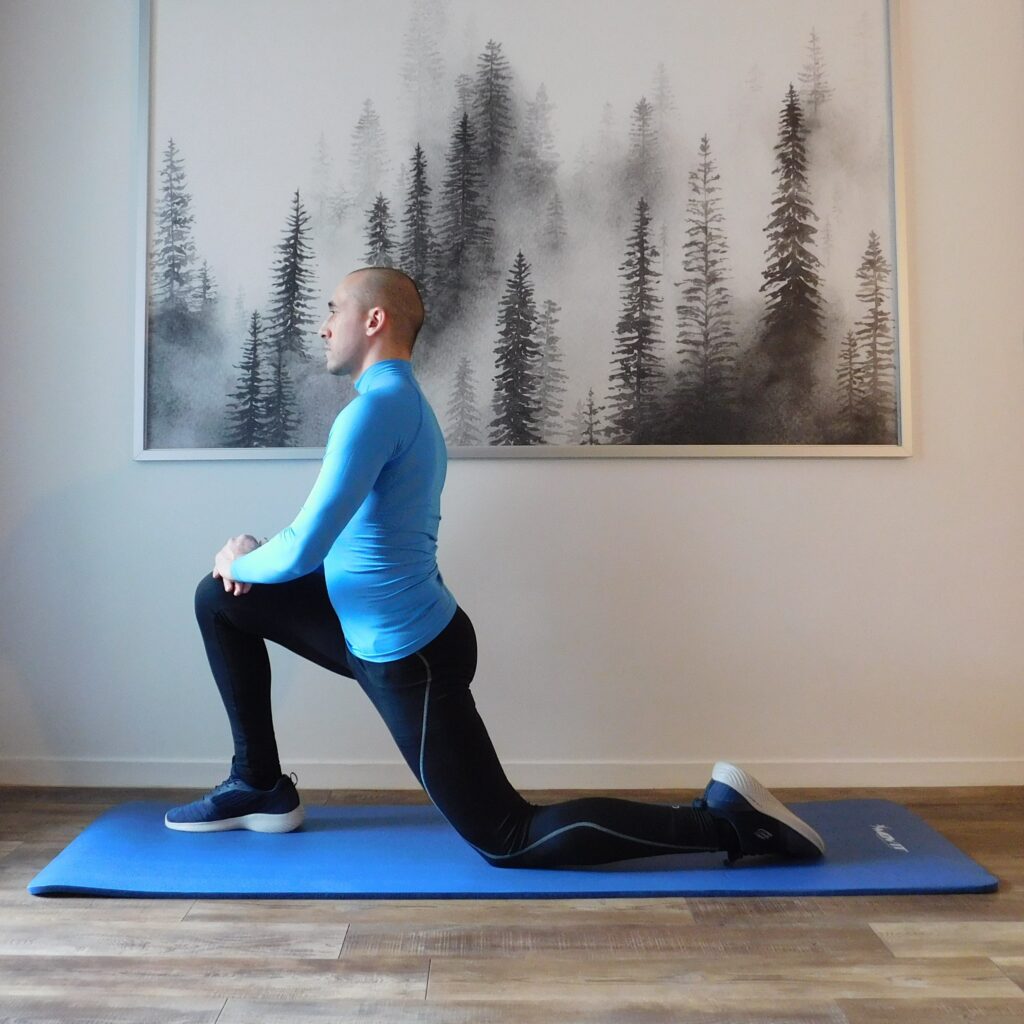
- Mettez-vous à genoux sur votre genou gauche. Placez votre pied droit à plat sur le sol devant vous, genou plié.
- Penchez-vous vers l’avant en étirant votre hanche gauche vers le sol.
- Serrez vos fesses, cela vous permettra d’étirer encore plus votre fléchisseur de hanche.
- Maintenez cette position entre 30 et 60 secondes.
- Changez de côté et répétez, puis alternez une seconde fois.
Étirements des ilio-psoas, des quadriceps et des fessiers.
2
Étirement des fessiers
Cette posture étire spécifiquement les muscles piriformes et ilio-psoas (essentiellement les muscles rotateurs et fléchisseurs de la hanche) ainsi que la bandelette de Maissiat. Grâce à cela et à la nature passive de la posture, c’est une approche excellente et douce pour aider à soulager les symptômes associés à la sciatique et aux douleurs du genou.
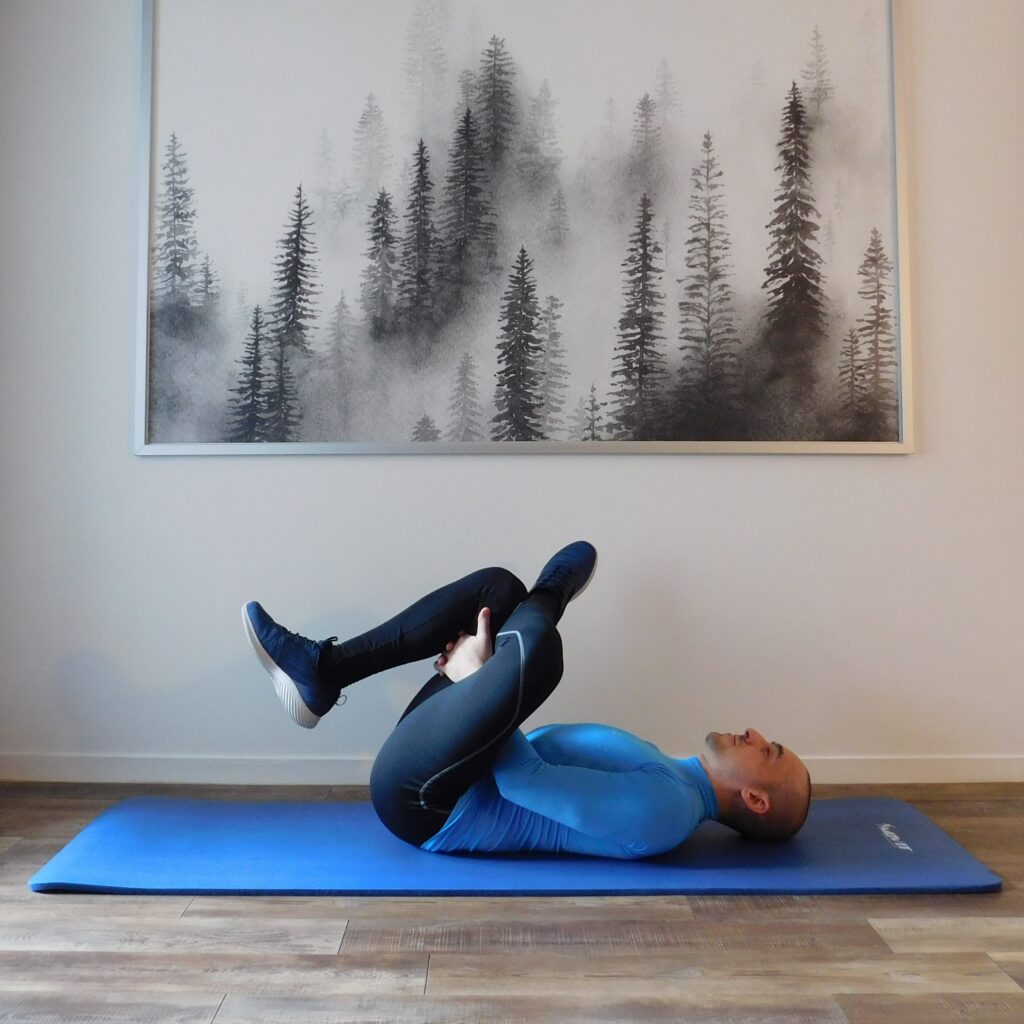
- Allongez-vous sur le dos, les pieds à plat sur le sol.
- Croisez votre pied gauche sur votre genou droit.
- Soulevez votre jambe droite du sol. Attrapez l’arrière de votre cuisse droite (ou le devant de votre jambe si vous êtes souple) et tirez-la doucement vers votre poitrine.
- Lorsque vous ressentez un étirement confortable, maintenez cette position.
- Maintenez cette position entre 30 et 60 secondes.
- Changez de côté et répétez, puis alternez une seconde fois.
Étirements des hanches, des fessiers, des lombaires et des ischio-jambiers.
3
Étirement des ischio-jambiers
The ischio-jambiers soutiennent les hanches et les genoux. Les blessures au genou peuvent être causées par des élongations des ischio-jambiers, il est donc important de s’en prémunir en gardant les ischio-jambiers souples et mobiles.
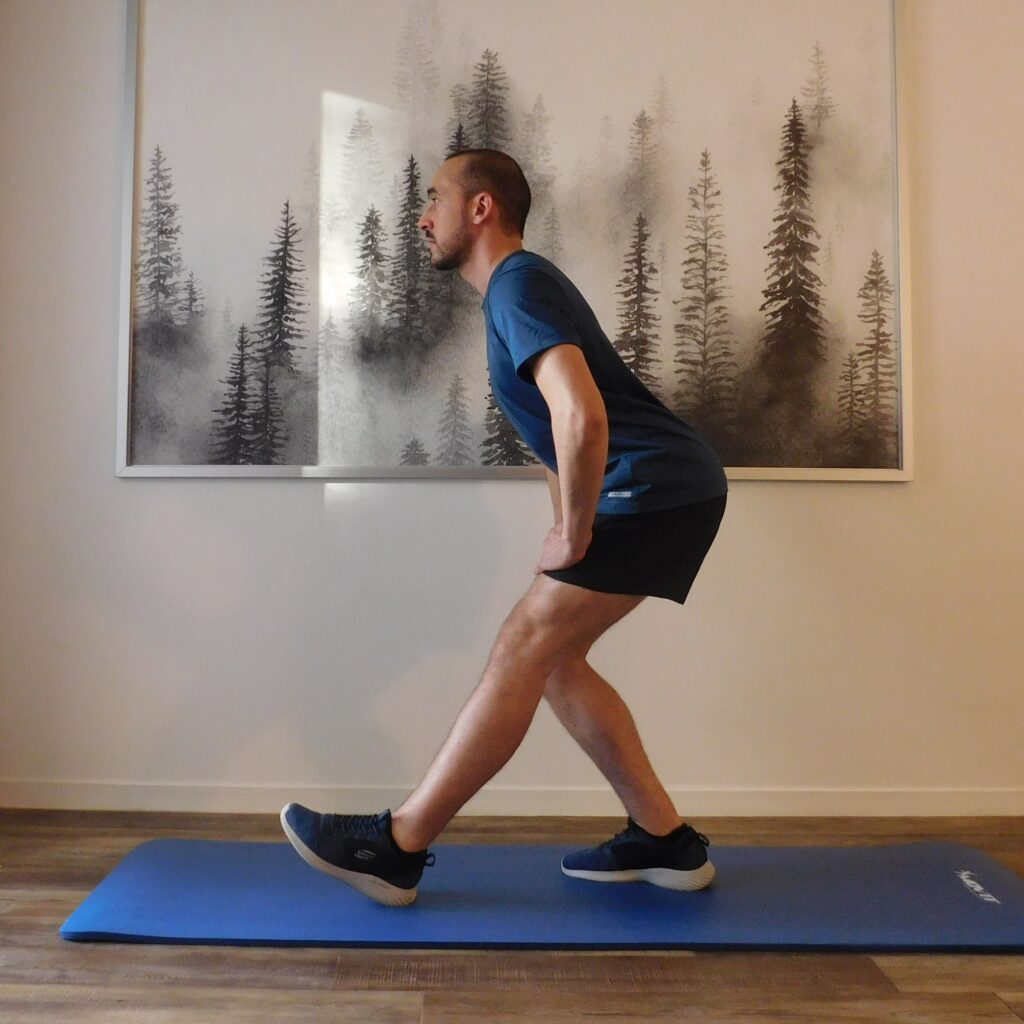
- Mettez-vous sur le pied droit, le pied gauche devant vous, le talon au sol, les orteils vers le haut.
- Basculez les hanches vers l’avant et pliez le genou droit en vous asseyant un peu en arrière.
- Tout en pliant votre jambe droite, gardez votre jambe gauche complètement droite, votre poids reposant sur le bord de votre talon. Vous devriez sentir cet étirement dans l’ischio-jambier de la jambe tendue.
- Maintenez cette position entre 30 et 60 secondes.
- Changez de côté et répétez l’exercice.
Étirements des fessiers et des ischio-jambiers.
4
Étirement des mollets
Des mollets raides peuvent exercer une pression sur l’arrière du genou. Cela peut également exercer une pression sur vos pieds et contribuer à des blessures telles que la fasciite plantaire, qui provoque des douleurs près du talon.
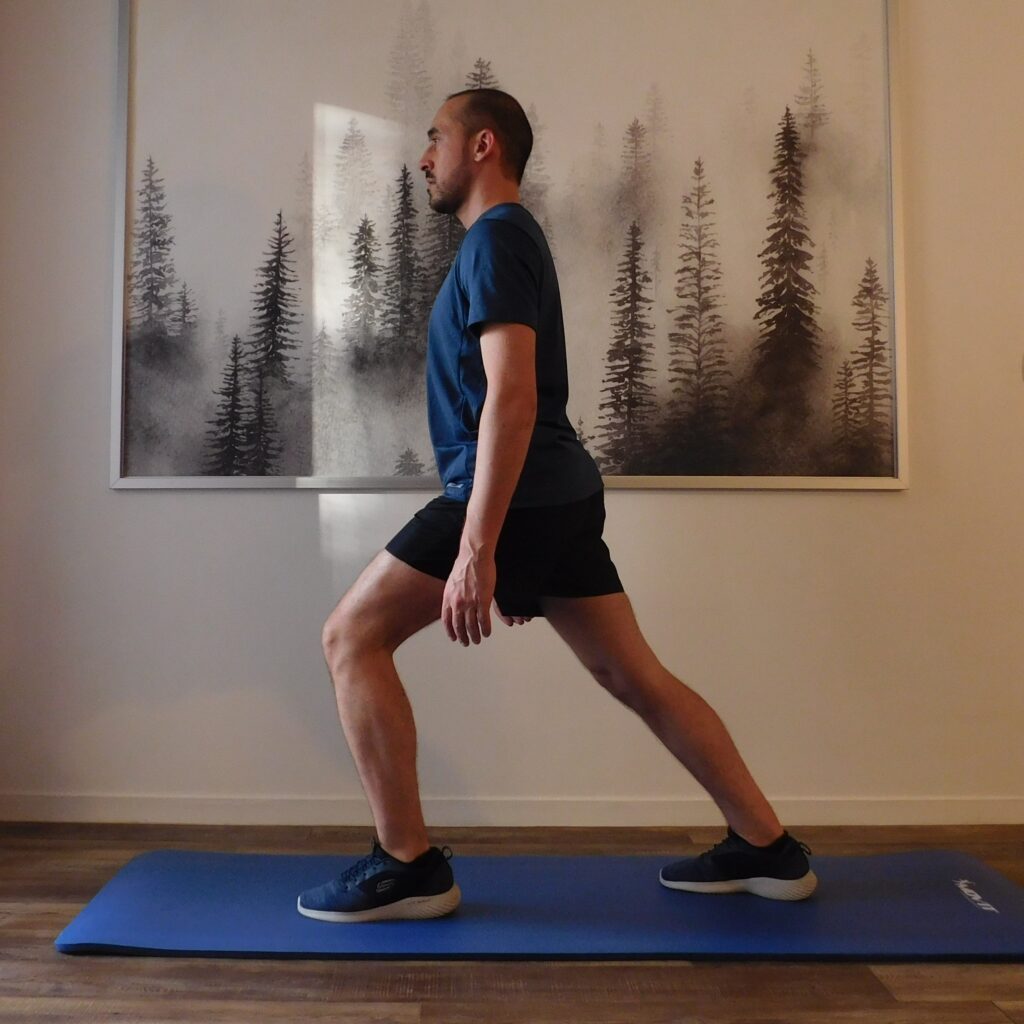
- Placez-vous en fente, une jambe tendue derrière vous et l’autre devant vous, légèrement fléchie.
- Gardez la jambe arrière droite, le talon posé sur le sol, le dos étant droit.
Vous devez ressentir cette sensation dans le mollet de votre jambe arrière. - Maintenez cette position entre 30 et 60 secondes.
- Changez de côté et répétez l’exercice.
Étirements des mollets.
5
Étirement des quadriceps
L’étirement des quadriceps est l’un des étirements les plus populaires du bas du corps, surtout si vous venez de faire un entraînement d’endurance comme la course à pied ou le vélo. La version allongée, par opposition à la variante debout typique, ne nécessite pas d’avoir un bon équilibre.
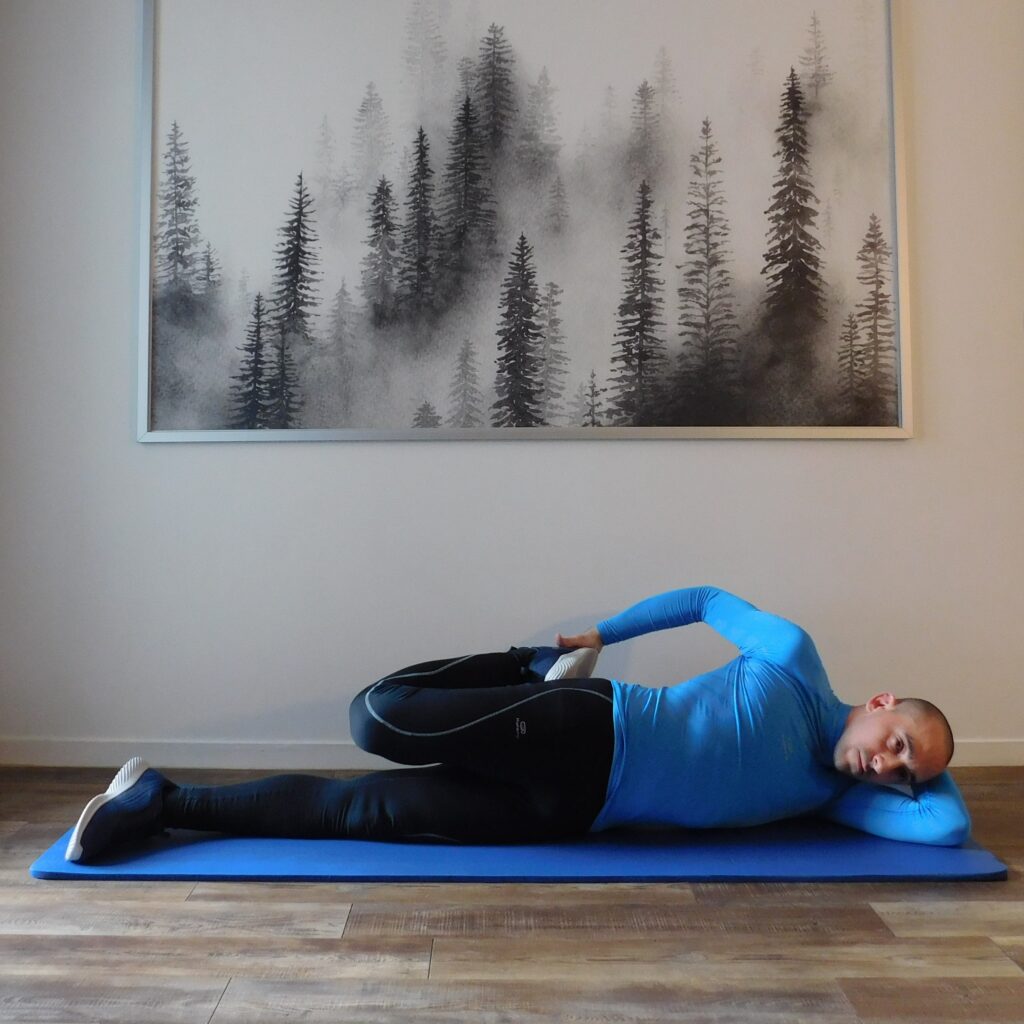
- Allongez-vous sur un côté.
- Gardez votre jambe inférieure droite et pliez votre genou supérieur de façon à ce que votre pied soit près de votre fesse.
- Tenez votre pied supérieur avec votre main, en le tirant vers vos fesses.
- Gardez vos hanches stables pour ne pas basculer en arrière lorsque vous tirez.
- Maintenez cette position entre 30 et 60 secondes.
- Changez de côté et répétez, puis alternez une seconde fois.
Étirements des quadriceps.
6
Étirement du quadriceps debout
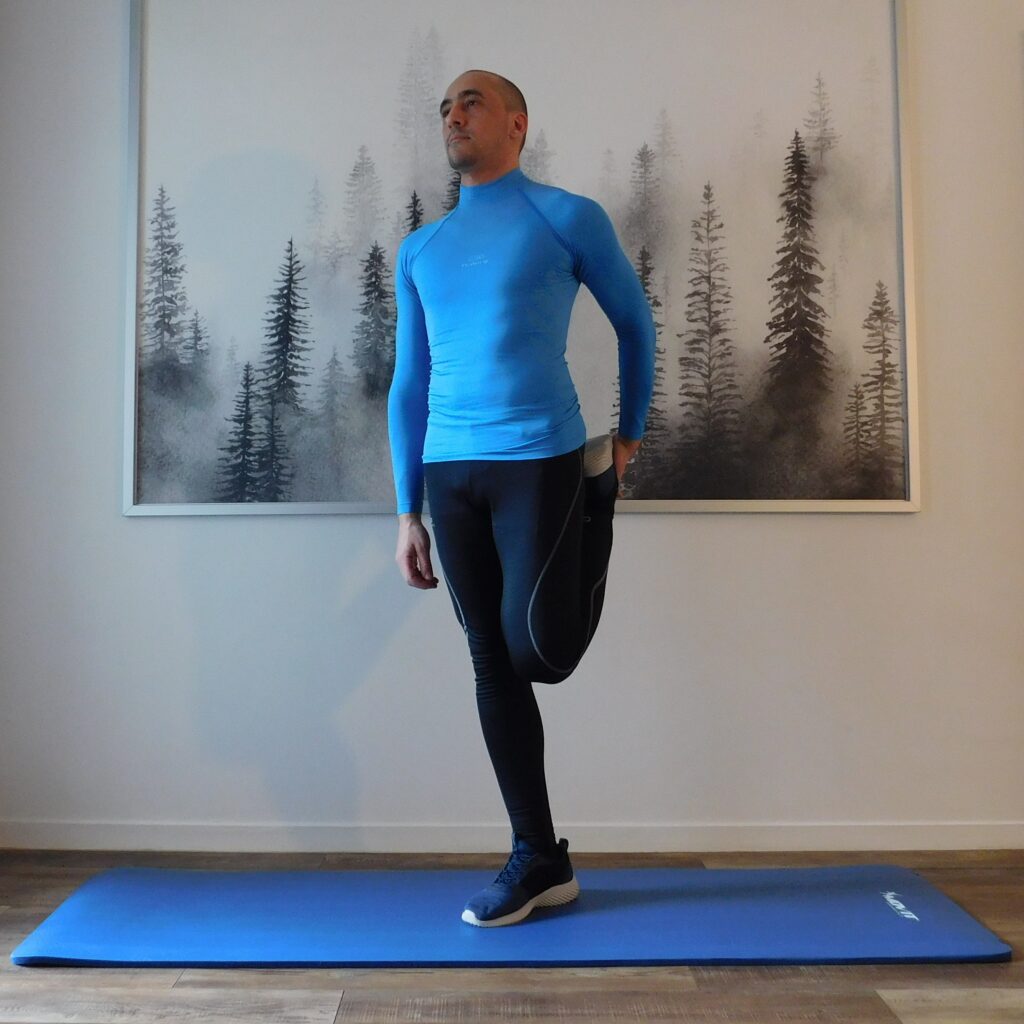
- Mettez vous debout, les pieds joints.
- Pliez votre genou gauche et utilisez votre main gauche pour tirer votre pied gauche vers votre fesse gauche. Gardez les genoux serrés.
- Si vous en avez besoin, posez votre main droite sur un mur pour garder l’équilibre.
- Contractez vos fessiers pour augmenter l’étirement de l’avant de vos jambes.
- Maintenez cette position entre 30 et 60 secondes.
- Répétez l’exercice sur l’autre jambe, puis alternez une seconde fois.
Étirements des quadriceps.
7
Étirement des adducteurs en fente latérale
Cet étirement fait travailler les adducteurs, les muscles situés à l’intérieur des cuisses qui aident à stabiliser les hanches. Des adducteurs tendus peuvent entraîner une instabilité des hanches et du bassin et, en fin de compte, des genoux.
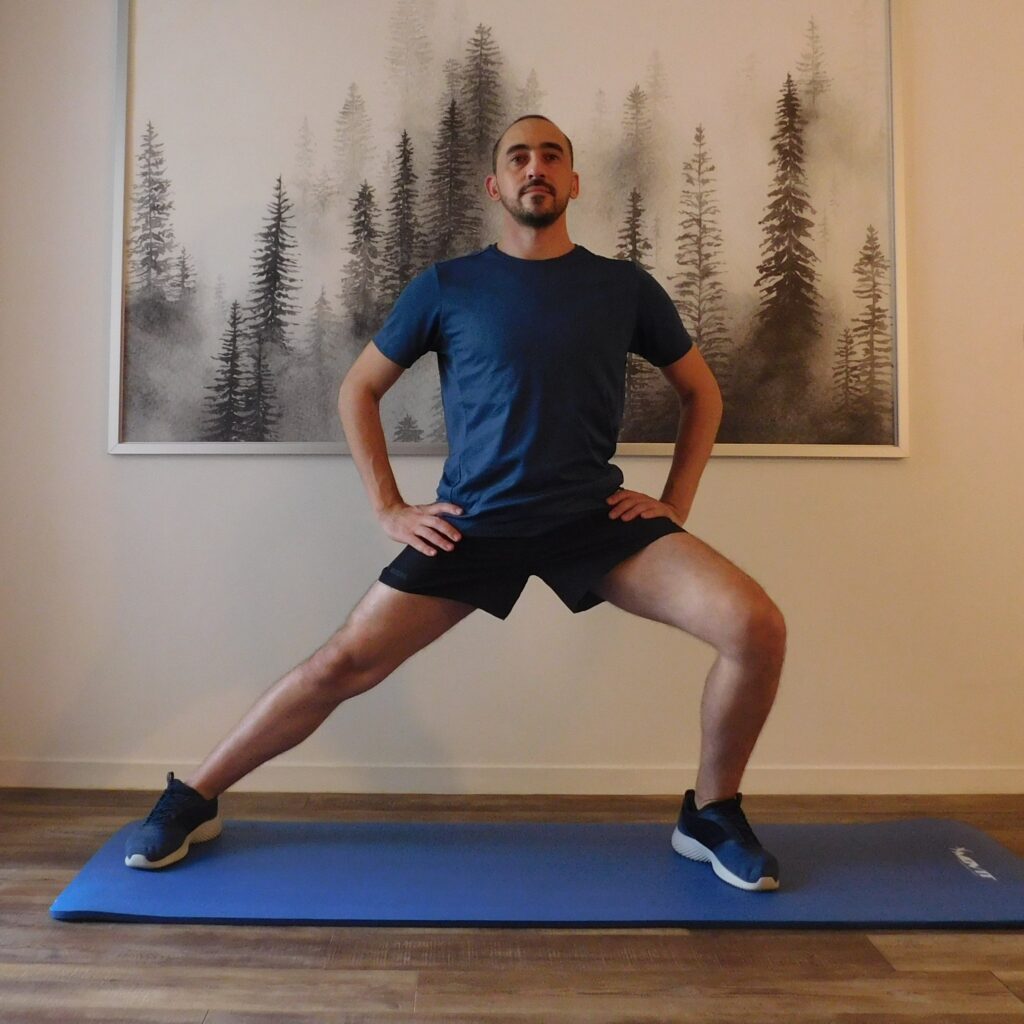
- Faites une fente sur le côté, en pliant le genou et en gardant la jambe opposée tendue.
- Essayez de garder le pied de votre jambe droite sur le sol autant que possible.
- Placez le bout de vos doigts sur le sol devant vous pour vous équilibrer si nécessaire.
- Vous devriez ressentir cet étirement au niveau des hanches et de l’intérieur des cuisses.
- Maintenez la position pendant 30 à 60 secondes.
- Changez de côté et répétez l’exercice.
Étirements des adducteurs.
Pour celles et ceux qui souffrent de douleurs au bas du dos, je vous invite à consulter l’article Soulager un lumbago grâce au yoga pour des étirements ciblés.
Pour des étirements complets du corps, vous pouvez consulter 21 exercices d’étirements pour une meilleure flexibilité.
Prenez soin de vous 🙏🏼
Partagez cet article avec vos proches et amis 🙂

